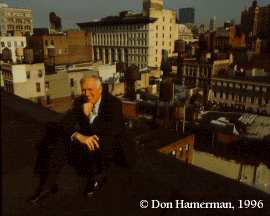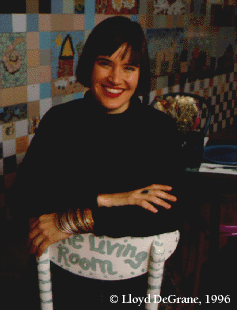 The University of Chicago Magazine February 1996
The University of Chicago Magazine February 1996

Where have you gone, Joe DiMaggio? That's what some readers of The Encyclopedia of New York City have been asking its editor, Kenneth Jackson. But when you're winnowing 370 years of history down to just one volume--granted, a 1.3-million-word book weighing 7 pounds, 6 ounces --some things simply have to go.
"I had nightmares for years that we'd leave out Harlem or Mayor La Guardia or the Empire State Building--some gigantic topic that everybody thought somebody else was going to cover," says Jackson, AM'63, PhD'66. "And then we'd open it up and say, `Greenwich Village--shouldn't that be in here?'"
Perhaps now Jackson can sleep better. Thirteen years in the making, the encyclopedia was published last fall by Yale University Press and the New York Historical Society. For its editor, chair of Columbia University's history department, it was an uncommon undertaking: a scholarly work also intended to be "accessible, affordable, and of general interest."
The book's more than 4,000 entries, written by some 650 contributors, delve into quintessential New York topics from cockroaches to theater, the Brooklyn Bridge to Woody Allen. It's a fitting tribute to a city that Jackson calls "the capital of capitalism, the capital of the world, and the capital of the 20th century."
Much as he appreciates New York, Jackson retains his affection for Chicago--"much more spread out and a little bit cleaner"--the first big city that he lived in. At the U of C, he wrote his dissertation on the urban Ku Klux Klan in the 1920s. Upon its completion, he was ordered to active duty with the Air Force in Vietnam.
Jackson joined Columbia in 1968. Students voted him teacher of the year in 1989, rewarding such efforts to stimulate their interest as his annual all-night bike tour of New York City. An advantage of urban history, he points out, is that cities still exist, and students can experience their history for themselves.
Crabgrass Frontier, which Jackson and critics deem his most significant book, focuses on suburbanization, a uniquely American trend. New York, he says, is one of the few major U.S. cities that hasn't declined in population over the last half-century and that still has its wealth concentrated in its center and not in its suburbs.
In the rest of the world, he says, people continue to migrate to cities, "for the same reason that most people have for centuries, which is that they offer people the greatest variety, the greatest economic hope, the greatest ability to escape from pettiness and meanness and discrimination." Jackson adds, "Within another year or two, for the first time in human history, more than half of humanity will live in cities."
He holds forth hope for U.S. urban centers in the form of a renaissance in Rust Belt cities like Cleveland and St. Louis and the assurance that metropolises like New York, Chicago, and Los Angeles are necessary and will be present and "probably prosperous"--though perhaps less dominant--for centuries to come.
Jackson's own future includes two major projects: a book on automobile and gasoline policies titled The Road to Hell and a case study of four economically disparate New York suburbs that asks why such extremes exist within a rich, powerful country.
There will also be, he promises, a revised and expanded edition of The Encyclopedia of New York History. Next time around, he's vowed to save some room for Joltin' Joe.--K.S.

Rainbow-hued tiles in the wall mural at The Living Room Cafe spell out "Welcome. Eat well. Feel good. Dream big." Designed for those with no living rooms--or kitchens or bedrooms, for that matter--the Cafe offers the South Side's homeless weekly helpings of dignity and respect along with eggs, pancakes, and fruit salad.
Founder Jennifer Wiener, a 1994 SSA graduate, wanted to provide "a positive, supportive atmosphere for people who really want to make a change in their lives." She's beginning with food: Free breakfasts have been served since October 21 to nearly 35 people every Saturday. The small capacity allows 26-year-old Wiener and her 14 volunteers to come to know their guests as individuals, earning their trust and learning their goals and needs. That's es-pecially important be-cause, Wiener insists, the Cafe is not meant to be "just a free meal."
Though for now the Living Room's nonedible offerings are limited as Wiener waits for more grant money to come through, she does her best to make guests aware of neighborhood resources. Patrons are usually referred by social-service agencies; Wiener and volunteers with social-work training interview and register people who walk in off the street, making sure they, too, want to turn their lives around.
The Cafe's primary service provider is the Mentoring, Training, and Employment Project, a Chicago agency that offers skills testing, job training, and literacy workshops. Other local agencies assist with substance-abuse problems, health care, and counseling. By October 1996, Wiener expects to be serving breakfast and dinner five days a week; later, she hopes to convert part of the Cafe into a library and work center.
Her inspiration came from a similar Cafe on Chicago's North Side--one of about ten in the country--where she volunteered during her last year of graduate school. Unlike agencies that focus on specific problems, Wiener says, a smaller program with a larger outlook, though serving fewer people, can effect change by influencing many aspects of a homeless person's life. When the time came to write her thesis, Wiener decided to research what it would take to start a Cafe of her own.
Not content to speculate, after graduation Wiener took action with tireless enthusiasm, calling everyone she knew for help in writing grant proposals, approaching potential donors, meeting community leaders, and choosing a site.
The place they decided on--a former fast-food restaurant at 6422 S. Cottage Grove Avenue--came with an intact kitchen and bathroom but not much else. Wiener and her crew convinced Chicago retailers like Crate & Barrel and Starbucks to donate everything from dishes and coffee to paint and the tiles for the mural. Children from the Robert Taylor public-housing projects--with whom Wiener works at her paying job, coordinating youth programs for Chicago Area Project--designed and helped install the mural, and helped paint the donated furniture in vivid shades of orange, purple, and green.
The finished space looks just like a restaurant--one as funky as Wiener's attire--with four or five chairs clustered around small tables set with tablecloths and flatware and vases of fresh flowers. A hand-written menu is posted on a board near the entrance. Volunteers act as cooks and waiters, coming to each table to take orders and serve filled plates.
While the food leads to conversation, Wiener hopes that the manner in which it's served leads to increased self-esteem for people who have forgotten what it's like to have options as simple as choosing from a menu.
"It's such a hard life, and you're going to shelters and soup kitchens--which are needed--but you're just in a line, you get what you get," says Wiener, recalling how startled her first guests were. "Just to realize that you have a choice again is a big thing."--K.S.
What's the news? We are always eager to receive your news at the Magazine, care of the Class News Editor, University of Chicago Magazine, 5757 Woodlawn Ave., Chicago, IL 60637, or by E-mail: uchicago-magazine@uchicago.edu.
To write us with your news directly, click here for our e-mail form: uchicago-magazine@uchicago.edu.
No engagements, please. Items may be edited for space. For that reason, starting with the February/96 issue we will no longer list all of the U of C alumni present at a wedding, but only those alumni who are relatives or were members of the wedding party. As news is published in the order in which it arrives, it may not appear immediately.
Please specify the year under which you would like your news to appear. Otherwise, we will list: (1) all former undergraduates (including those who later received graduate degrees) by the year of their undergraduate degree, and (2) all former students who received only graduate degrees by the year of their final degree.